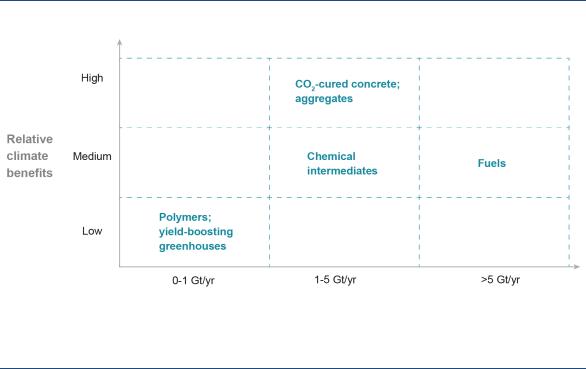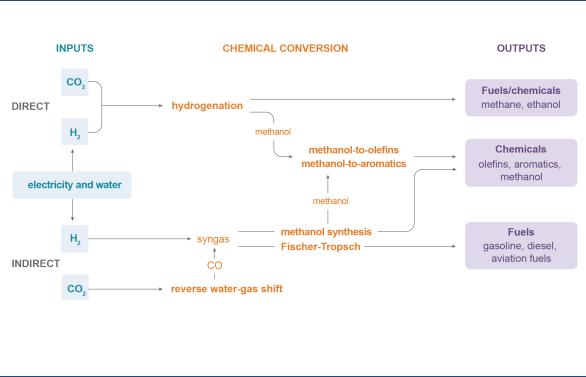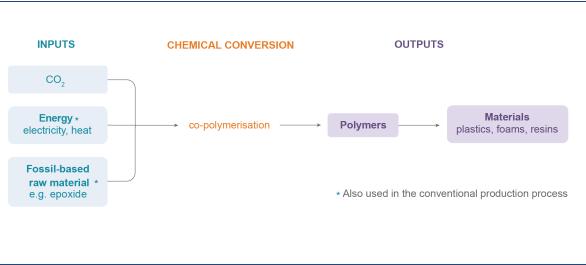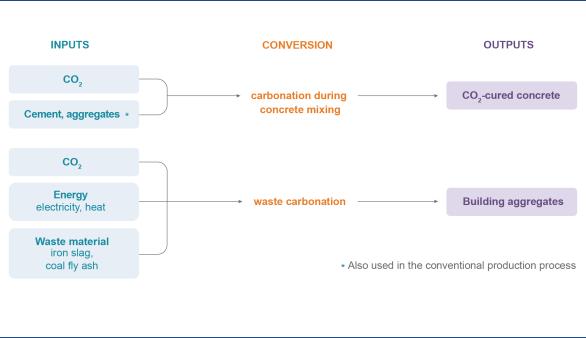
- •Putting CO2 to Use
- •Abstract
- •Highlights
- •Executive summary
- •CO2 is a valuable commodity
- •Early markets are emerging but the future scale of CO2 use is uncertain
- •Using CO2 can support climate goals, but with caveats
- •Cultivating early opportunities while planning for the long term
- •Findings and recommendations
- •Millions of tonnes of CO2 are being used today
- •New pathways for CO2 are generating global interest
- •CO2 use can contribute to climate goals, but with caveats
- •The future scale of CO2 use is highly uncertain
- •Where are the emerging market opportunities?
- •1. CO2-derived fuels
- •2. CO2-derived chemicals
- •3. Building materials from minerals and CO2
- •4. Building materials from waste and CO2
- •5. Crop yield boosting with CO2
- •CO2 use can complement CO2 storage, but is not an alternative
- •References
- •Policy recommendations
- •Technical analysis
- •Introduction
- •Setting the scene
- •What is CO2 use?
- •CO2-derived fuels
- •CO2-derived chemicals
- •CO2-derived building materials
- •Where is CO2 being used today?
- •What has spurred renewed interest in CO2 use?
- •Who is currently investing in CO2 use, and why?
- •How can CO2-derived products and services deliver climate benefits?
- •Understanding the future market for CO2-derived products and services
- •Which factors influence the future market?
- •Scalability
- •Competitiveness
- •The price and availability of hydrogen
- •The price and availability of CO2
- •Climate benefits
- •Origin of the CO2
- •Displaced product or service (reference system)
- •Energy input
- •Retention time of carbon in the product
- •Is it possible to assess the future market size?
- •Scaling up the market
- •CO2-derived fuels
- •What are CO2-derived fuels?
- •Are CO2-derived fuels scalable?
- •Under what conditions would CO2-derived fuels be competitive?
- •Can CO2-derived fuels deliver climate benefits?
- •What are the regulatory requirements?
- •CO2-derived chemicals
- •What are CO2-derived chemicals?
- •Are CO2-derived chemicals scalable?
- •Under what conditions would CO2-derived chemicals be competitive?
- •Can CO2-derived chemicals deliver climate benefits?
- •What are the regulatory requirements?
- •CO2-derived building materials from natural minerals
- •What are CO2-derived building materials?
- •Are CO2-derived building materials scalable?
- •Under what conditions would CO2-derived building materials be competitive?
- •Can CO2-derived building materials deliver climate benefits?
- •What are the regulatory requirements?
- •CO2-derived building materials from waste
- •What are building materials made from waste?
- •Are building materials from waste scalable?
- •Under what conditions are building materials from waste competitive?
- •Can building materials from waste deliver climate benefits?
- •What are the regulatory requirements?
- •CO2 use to enhance the yield of biological processes
- •What is yield boosting?
- •Is CO2 yield boosting scalable?
- •Under what conditions is CO2 yield boosting competitive?
- •Can CO2 yield boosting deliver climate benefits?
- •What are the regulatory requirements?
- •Where are suitable locations for an early market?
- •Implications for policy
- •Public procurement
- •Mandates
- •Economic incentives
- •Labelling, certification and testing
- •Research development and demonstration
- •Recommendations
- •References
- •General annex
- •Abbreviations and acronyms
- •Acknowledgements
- •Table of contents
- •List of figures
- •List of boxes
- •List of tables

Putting CO2 to Use: Creating Value from Emissions |
Findings and recommendations |
The market for CO2-derived products and services is expected to remain small in the short term. Individual markets are either small in nature (polymers, greenhouses), limited to locations with favourable conditions (methane, methanol) or face other barriers for fast deployment, such as building standards and codes (building materials).
Figure 4. Theoretical potential and climate benefits of CO2-derived products and services
IEA 2019. All rights reserved.
Fuels show the greatest potential for CO2 use by volume, while building materials have the greatest potential to deliver climate benefits per tonne of CO2 used.
Where are the emerging market opportunities?
The IEA has identified five key categories of CO2-derived products and services that are attracting significant global interest and considered the near-term requirements to increase the market for these applications to at least 10 MtCO2 use per year. This is almost as much as the current CO2 demand for food and beverages. The analysis finds that technologically all of these applications could be scaled up but would face commercial and regulatory barriers.
1. CO2-derived fuels
The carbon in CO2 can be used to produce fuels that are in use today, including methane, methanol, gasoline and aviation fuels. The process involves using the CO2 in combination with hydrogen, which is highly energy-intensive to produce, and results in a carbon-containing fuel that is easier to handle and use than pure hydrogen (Figure 5). Low-carbon hydrogen can be produced from fossil fuels when combined with CCS, or through electrolysis of water using lowcarbon electricity (IEA, 2019b).
CO2-derived fuels are particularly interesting for applications where the use of other low-carbon energy carriers, such as electricity or hydrogen, is extremely challenging, such as in aviation. Several firms have already built demonstration and pilot plants producing methane and methanol from CO2 and hydrogen, together using hundreds to thousands of tonnes of CO2 per year. Other chemical and biological conversion pathways to produce CO2-derived fuels are in the early research or demonstration stages.
PAGE | 9
IEA. All rights reserved.

Putting CO2 to Use: Creating Value from Emissions |
Findings and recommendations |
Figure 5. Mature conversion route for CO2-derived fuels and chemical intermediates
IEA 2019. All rights reserved.
CO2 can be used to produce fuels and chemical intermediates through several conversion routes but require significant energy input.
Estimated production costs of methanol and methane from CO2 in most regions of the world are currently 2 to 7 times higher than for their fossil counterparts. The chief cost factor is typically electricity, accounting for between 40-70% of the production costs, and hence very low average grid electricity prices are required for CO2-derived methanol and methane to be competitive. Even under these conditions, the direct use of low-carbon hydrogen and electricity as a fuel will be a more cost-effective option in most cases.
Commercial production of CO2-derived methanol and methane could be possible in markets where both low-cost renewable energy and CO2 are available, such as in North Africa, Chile or Iceland. A prime example is the George Olah facility in Iceland that converts around 5 600 tonnes of CO2 per year into methanol using hydrogen produced from renewable electricity (CRI, 2019).
Over time, production costs of CO2-derived fuels are expected to come down, mainly due to capital cost reductions and availability of low-cost renewable electricity and feedstock CO2. While CO2-derived methane and CO2-derived liquid fuels, such as diesel or aviation fuels, will continue to be uncompetitive in the absence of a stringent CO2 price regime, CO2-derived methanol may become competitive in more regions around the world, depending on local methanol market prices.
Both CO2-derived methane and methanol can provide climate benefits, but the use of lowcarbon energy for their production is critical. Analysis of the relevant literature shows that, in a best case scenario, emissions can be reduced by 74% to 93% for methanol and 54% to 87% for methane as compared to conventional production routes (Artz et al., 2018). However, extensive testing is needed before these products can be recognised by existing product quality standards.
PAGE | 10
IEA. All rights reserved.

Putting CO2 to Use: Creating Value from Emissions |
Findings and recommendations |
2. CO2-derived chemicals
The carbon (and oxygen) in CO2 can be used as an alternative to fossil fuels in the production of chemicals, including plastics, fibres and synthetic rubber. As with CO2-derived fuels, converting CO2 to methanol and methane is the most technologically mature pathway. The methanol can be subsequently converted into other carbon-containing high-value chemical intermediates such as olefins, which are used to manufacture plastics, and aromatics, which are used in a range of sectors including health and hygiene, food production and processing.
A special group of chemicals, polymers, are used in the production of plastics, foams and resins. The carbon in CO2 can be used in polymer production by replacing part of the fossil fuel-based raw material in the manufacturing process (Figure 6). Unlike the conversion of CO2 to fuels and chemical intermediates, polymer processing with CO2 requires little energy input, because CO2 is converted into a molecule with an even lower energy state (carbonate). A number of companies are currently operating polymer plants using CO2 as a raw material.
Figure 6. Mature conversion pathway for CO2-derived polymers
IEA 2019. All rights reserved.
CO2 can be converted into polymers that can be used in a wide variety of products.
Polymer processing with CO2 can be competitive in the market, due to the relatively low energy required for their production and their high market value. Some claim that certain polymers can be made at 15% to 30% lower cost than their fossil counterparts, provided the CO2 used is cheaper than the fossil fuels-based raw material it replaces (von der Assen, 2015). The Chimei Asai facility in Chinese Taipei, a joint venture of Asahi Kasei Chemicals and Chi Mei Corp, has been manufacturing around 150 000 tonnes of polycarbonates per year using CO2 as a starting material for more than a decade (Fukuoka et al. 2007). Although the potential market for polymers is relatively small, early opportunities for polymer processing with CO2 may be available in locations where existing polymer plants can be modified and where fossil fuel prices are high.
Potential climate benefits in polymer production depend on the amount of CO2 that can be absorbed in the material, which can be up to 50% of the polymer’s mass (Alberici et al., 2017). For example, a polymer containing 20% CO2 by weight shows life cycle CO2 emissions reductions of 15% relative to the conventional production process (von der Assen, 2015). Similarly to CO2-derived fuels and chemicals, further compliance testing is needed before polymers with high mass percentages of CO2 can enter the market.
PAGE | 11
IEA. All rights reserved.

Putting CO2 to Use: Creating Value from Emissions |
Findings and recommendations |
3. Building materials from minerals and CO2
CO2 can be used in the production of building materials to replace water in concrete, called CO2 curing, or as a raw material in its constituents (cement and construction aggregates). These applications involve the reaction of CO2 with calcium or magnesium to form low-energy carbonate molecules, the form of carbon that makes up concrete (Figure 7). CO2-cured concrete is one of the most mature and promising applications of CO2 use, while the integration of CO2 in the production of cement itself is at an earlier stage of development.
Figure 7. Mature conversion pathway for CO2-derived building materials
IEA 2019. All rights reserved.
CO2-derived building materials can be made from CO2 through a carbonation process.
CO2-cured concrete can have superior performance, lower manufacturing costs and a lower CO2 footprint than conventionally-produced concrete. The climate benefits come mainly from the lower input of cement, which is responsible for the bulk of the costs and life-cycle emissions of concrete. Two North American companies, CarbonCure and Solidia Technologies, are leading the development and marketing of CO2 curing technology (CarbonCure, 2019; Solidia, 2019).
Quantifying the potential of CO2-cured concrete to reduce emissions remains difficult. CarbonCure reports that the CO2 footprint of concrete can be reduced by around 80%, but these claims have not been verified independently (CarbonCure, 2019). A highly prospective opportunity for early application of these technologies is the market for pre-cast concrete products and ready-mixed concrete that is cured with CO2 and water at the plant before being transported for use in construction.
Existing regulations and product standards may stand in the way of early application in certain parts of the market. Updating existing product standards can take up to a decade; multi-year trials must demonstrate safe and environmentally friendly performance. A shift from prescriptive to performance-based standards could facilitate the uptake of novel CO2-derived building materials.
In the interim, non-structural applications of concrete for which high mechanical strength is not required (for example construction of roads, floors and ditches) could be a target for early deployment of these new products.
PAGE | 12
IEA. All rights reserved.
